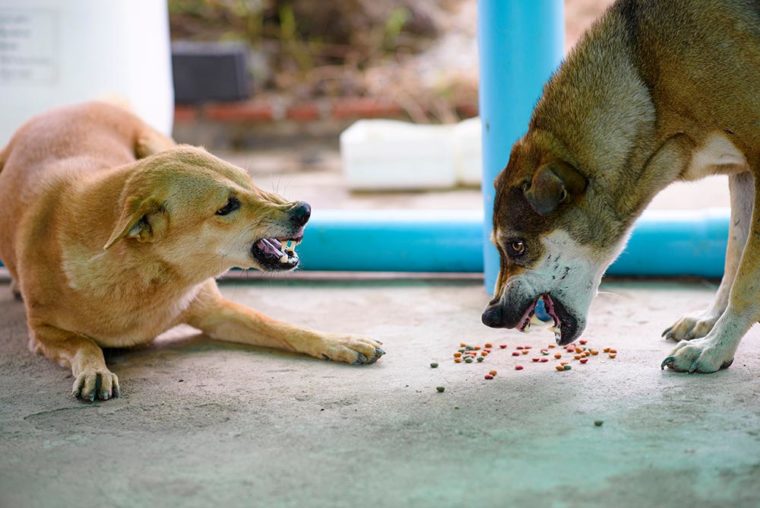
Click to Skip Ahead
Food aggression is a relatively common, yet undesirable behavior where a dog feels the need to show aggression to protect their food. Food aggression can be dangerous and leaves open the possibility of injury to people or other animals in the home.
Here, we will talk about the signs of food aggression, what causes a dog to become food aggressive, and some potential solutions to the behavior.

The 8 Signs of Food Aggression
1. Hovering Over the Food
One of the first signs that a dog may be displaying food aggression is by hovering over their food. This is called food guarding. At this point, the dog feels very protective over their meal so they are using their body to protect their food from anyone nearby.
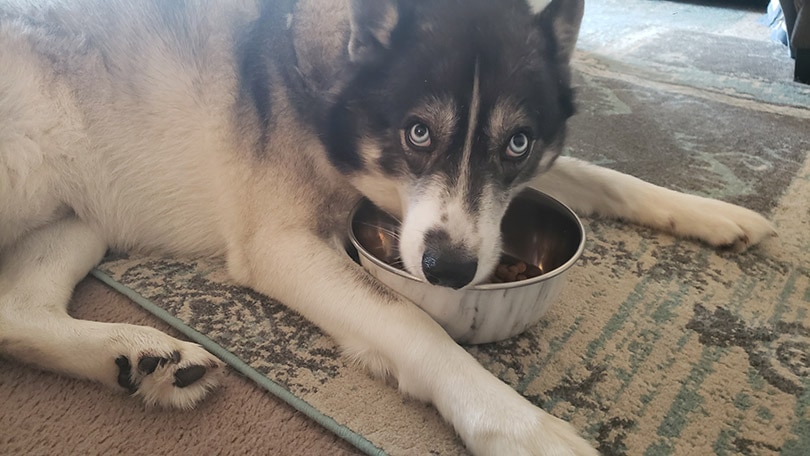
2. Gulping Food
Some dogs eat extremely fast by nature and will gulp down their food. Some dogs are very food-motivated and really enjoy mealtime, so gulping food doesn’t always signal food aggression, but it certainly can. You need to be watchful of this behavior because it can be a sign that they are trying to eat their food as fast as possible so that no one else can get it. Keep an eye out for the other signs of food aggression listed above.
When the dog is gulping down their food they have likely not yet shown signs of aggression, though some may growl as they eat. If you determine the food gulping is unrelated to food aggression, there are some tips and tricks to help ease the behavior and there’s no harm in contacting your veterinarian for some advice.
Pet behaviors can be caused by all kinds of things, but sometimes the source is medical. You can manage veterinary costs with the help of a pet insurance company like Lemonade, which offers adjustable plans and balanced coverage.
3. Freezing in Place When a Human or Animal Comes Near
If your dog freezes in place when a human or animal approaches their food, this is a surefire sign they are food guarding and may act out in aggression. The dog will go from eating to quickly freezing in place. You may notice their eyes track whoever is near them. At this point, you need to be very cautious and watch for other signals, as the behavior can escalate quickly.

4. Ears Back, Eyes Watchful, Lowered Tail
Dogs communicate quite a bit through body language. Their ears may go back for several reasons including excitement, showing submission, or fear. There are times when a dog’s ears will go back when they begin guarding their food. They may even raise their hackles, though it can be hard to distinguish hackles on some breeds. You may also keep your eye out for tail lowering.
While the ears alone are not indicative of food aggression, if this happens while they are eating you should keep watchful for other signs of food aggression. At this point, you may notice them staring intently, as their eyes track whoever has come near their food. They may also stiffen up and become rigid or even start growling or baring teeth.
5. Growling
If your dog is growling during mealtime, you need to be very careful of further aggressive behavior. At this point, they are warning whatever has approached their food that they are aware of their presence and are not welcome. By the time a dog has begun growling, they have most likely displayed some of the other signs mentioned above. Food aggression can range from mild to severe but can escalate quickly. Be mindful of any animals or humans near a food-aggressive dog.
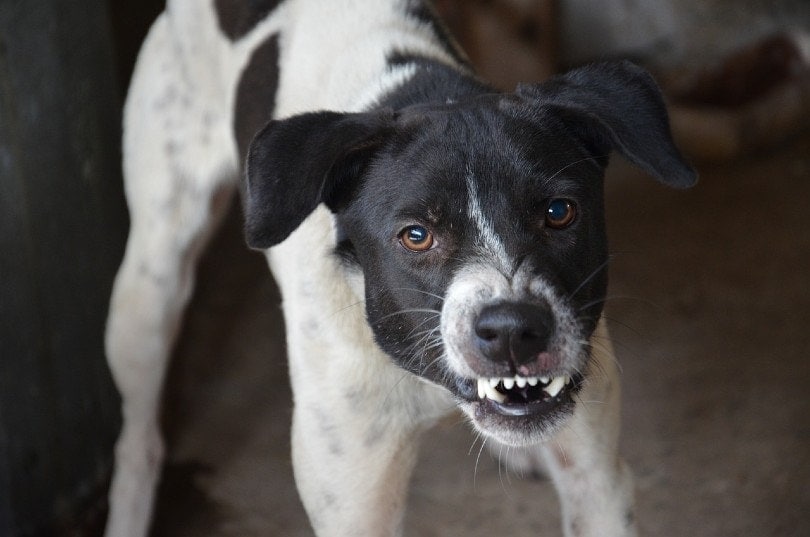
6. Baring Teeth
Baring teeth is yet another warning for anyone approaching the food to step away. They are feeling highly protective over their food, and they are using this behavior to make the threat to their meal disappear. Baring teeth is not always accompanied by growling or rigidity, but it may be. Some dogs may even bare their teeth as they are eating their food.
7. Lunging at the Perceived Threat
Lunging is a sign of moderate to severe food aggression. When lunging, the dog is feeling extremely protective over their food and is showing their will. Lunging is another way of getting the person or the animal to go away. Lunging can often be accompanied by snapping or biting.

8. Snapping or Biting
Snapping and biting are certainly not behaviors you want your dog displaying, as they can result in injury, but it is not uncommon for food aggressive dogs to resort to this behavior. Now that we’ve gone over all of the signs of food aggression, we’ll dig further into the subject and investigate the causes and what you can do about it.

Causes of Food Aggression
There isn’t one simple cause for food guarding and aggression, but there are a few common reasons why your dog is displaying this type of behavior:
Learned in Puppyhood
Puppies are brand new to the world and learning how to survive. Food aggression is an inherited pack behavior that has been passed down through ancestry. Thousands of years of domestication aside, dogs will still display instinct.
Puppies may learn young that they must compete for food over their littermates. Food can be limited when shared among others and if they don’t fight for it, they may not eat.

Lack of Training
Food guarding and aggression may result in a lack of training on the owner’s part. Since this can be the result of inherited, natural behavior, it is up to the owner to properly train their puppy that this behavior is unacceptable.
If a puppy comes home and displays food aggression, they are at an ideal age to manage the behavior and train them to behave properly. If training is neglected, you can wind up with an adult dog with food aggression.
Trauma, Abuse, or Neglect
Trauma, abuse, or neglect are all potential causes of food aggression. If a dog has been abused and deprived of food or suffered abusive conditions, it may make them feel the need to protect it when they do have it.
In neglect situations, they may have been left to fend for themselves and find their food, this can lead them to feel the need to be possessive. Trauma can be a powerful trigger as well. If a dog has been rehomed or has lost their owner and has been moved to a new place, it can lead them to more protective behaviors.
Competition
When a dog has experienced having to compete over food and actively experienced the need to guard their resources, this can lead them to food-aggressive behaviors. Maybe they had been in a shelter situation, the dog had survived time as a stray, or they were in a home that did not regulate feedings among others. The dog does not realize they are in a situation where this behavior is no longer warranted.
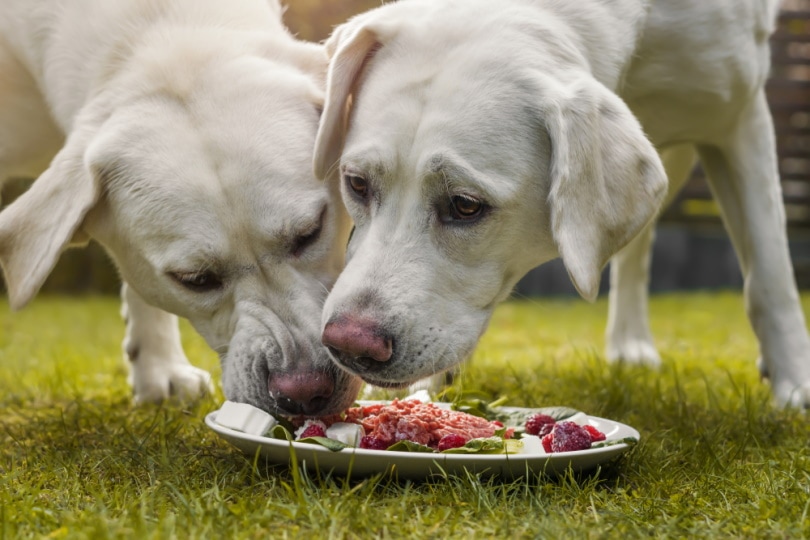

How to Stop Food Aggression
Once you’ve determined your dog is displaying food aggression, you need to take steps to solve this problem. Here are some potential solutions for food guarding and aggression. First ask yourself whether the behavior is limited to food, or if the dog shows possessive tendencies over toys, certain people, or places in the house. This would be considered resource guarding and will require training in different areas.
1. Determine the Level of Food Aggression
First and foremost, you need to determine just how severe the food aggression is. Food aggression is broken down into three subcategories: mild, moderate, and severe. Once you’ve determined what the level is, it will be easier to move forward with training.
2. Have a Consistent Routine
Not only should every dog owner establish themselves as a pack leader to prevent unwanted behavior and to have a sound social structure within the household, but you also need to keep your dog in a routine. Make sure to feed them at the same time each day and try to get your daily walks or exercise in at consistent times as well and always feed after walks or playtime, never beforehand.
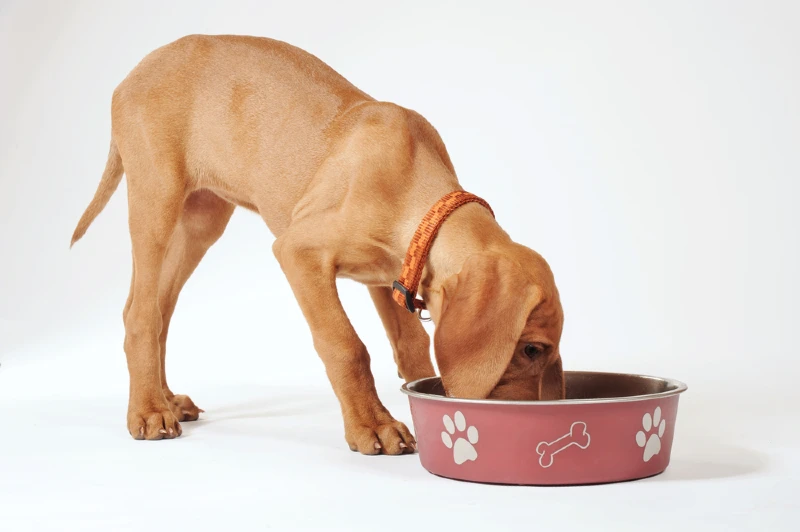
3. Make Your Dog Work for Food
Before offering your dog their meal, give them a command such as sit, stay, or wait and do not allow them access to their food until you say so and release them from the command. The dog must be trained to remain in command even after the food bowl has been set down. Remain close when you release them from the command. This makes them see the food as a reward for good behavior, and you are in control.
4. Humans Always Eat First
Dogs are pack animals, and in the wild, the pack leader always eats first. So, when training your dog, mealtime consistency is important and so is ensuring all humans in the household are eating before the dog(s). Once all humans are finished eating, the dogs can then have their meal. This helps to reinforce to them who the pack leader is.
5. Implement Training Techniques
Training is necessary when battling food aggression. If you feel uneasy or unsure of yourself at first, try reaching out to a professional trainer for some help. Here are some training techniques you can implement:
Hand Feeding
Hand-feeding your dog can be very helpful in this process. It’s a good idea to do this with brand new puppies. This will get your dog used to your hands being near their face while they eat. Also, use your hands to put the food in the bowl rather than using a cup. This will help them associate your scent with their food.
Toss Treats
While your dog is eating, walk up to the bowl and toss in their favorite treat. This will reinforce to them that a person approaching their bowl is a good thing. Rather than feeling like you will take from them, you are giving to them.
Offer Something Special
Like tossing treats, while your dog is eating, try and approach them with something special like a nice piece of meat or a treat they only get on special occasions. You are trying to stop your dog from eating their food and eating what you are offering. It can reinforce that no one is stealing their food when they break their attention from it and that a human near their food comes with a reward.
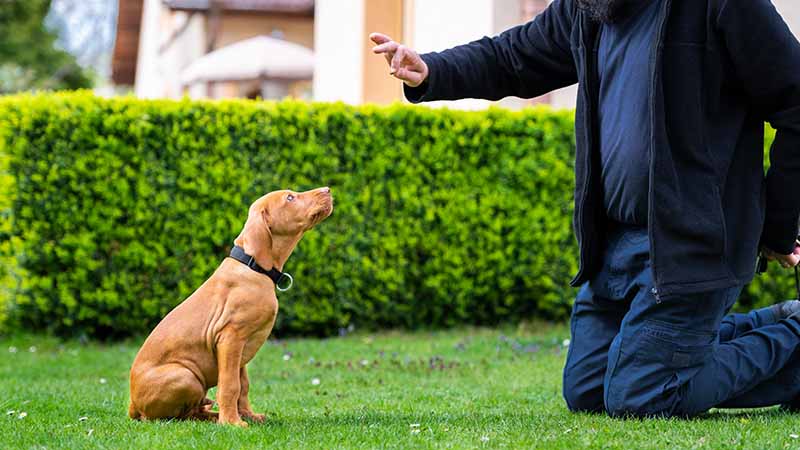
6. Consult a Professional
It’s always a good idea to get a professional opinion, especially if your dog is severely food aggressive or is showing this aggression toward other animals. A professional dog trainer can guide you along in the training process and may even work with them one on one.

How to Prevent Food Aggression
The best way to handle food aggression is to get ahead of it and prevent it from becoming a problem. This isn’t always possible, as some dogs may come into their new home with this behavior already ingrained.
1. Train, Train, Train
For those with new puppies or dogs that have no history of the behavior, you can certainly work with them and implement training techniques to prevent food guarding altogether. You can implement the training techniques listed above when you bring home a new puppy. You can also help get them comfortable with other animals approaching their bowl during the training process to prevent aggression toward other animals.
2. Don’t Allow Free Feeding
If you have a multiple dog household and place down a certain amount of food to allow them to graze and eat freely, this can lead to food aggression. If the food is left out all the time and everyone is allowed to eat when they please, this doesn’t ensure all pack members are getting their fill. It can easily lead to food guarding and aggression. Feed consistently at certain times during the day for best results.
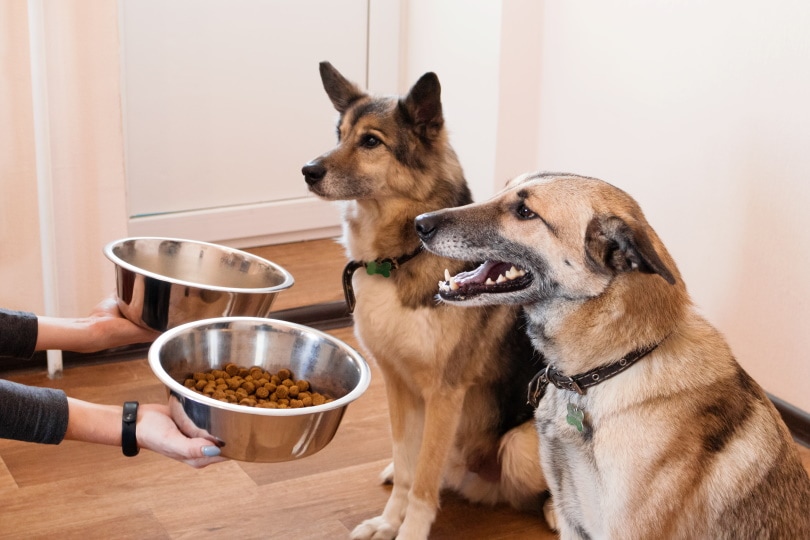
3. Feed in a Quieter Area
Most of the time, dogs are fed in more high-traffic areas in the house. This can lead them to feel overwhelmed by everyone coming so close to their food and may cause them to get defensive. A more quiet feeding spot with proper training to prevent resource guarding overall can make a huge difference.

Conclusion
The signs of food aggression are pretty straightforward. If you know what to look for in terms of body language and the signs associated with the behavior, you can be better prepared to deal with it overall. Food aggression can result from a variety of reasons, but it is important for the safety of everyone in the household that the behavior be corrected as soon as possible.
There are different training techniques that you can implement to resolve the behavior, or you can consult a professional. The best thing to do is start training early to prevent the behavior from the very beginning.
Featured Image Credit: Tanakon Phoophaphiw, Shutterstock







